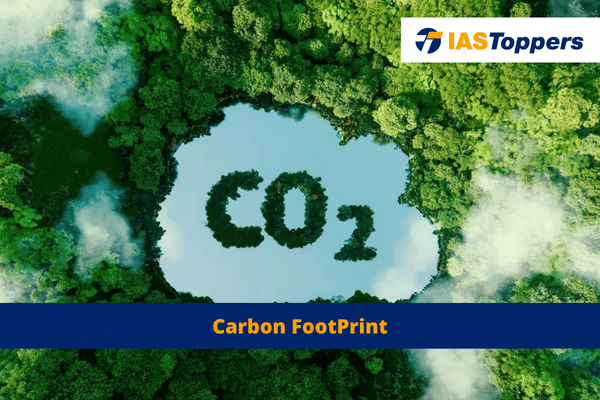Carbon FootPrint is the release of a specific number of gases into the atmosphere as a result of human activities related to production or consumption. In this article, you will learn meaning, examples, causes of carbon footprint, importance, ways to reduce carbon footprint, measure, methodology, effects of carbon footprint providing key insights for GS Paper-III Environment and Ecology section of UPSC IAS Exam.
Table of Content
- Table of Content
- What is Carbon FootPrint?
- Objectives of carbon footprint:
- Components of Carbon Footprint:
- How to calculate carbon footprint?
- Personal carbon footprint:
- The Carbon Footprint of Companies:
- Some of the Effects of Carbon Footprint:
- How to Reduce Carbon Footprint?
- Difference between carbon footprint and ecological footprint
- Conclusion
- Frequently Asked Questions
- Reference
What is Carbon FootPrint?
- A carbon footprint is the release of a specific number of gases into the atmosphere as a result of human activities related to production or consumption.
- A carbon footprint is also known as a greenhouse gas footprint.
- A carbon footprint includes the emission of greenhouse gases from electricity and heat (31%), agriculture (11%), transportation (15%), forestry (6%) and manufacturing (12%).
- Carbon footprint emissions have a significant impact on climate change.

Objectives of carbon footprint:
- Global carbon footprint acts as the headline indicator for climate change.
- As per the World Health Organization (WHO), a carbon footprint refers to the measurement of the influence of individuals’ actions on the generation of carbon dioxide (CO2) from burning fossil fuels.
- It is quantified as the weight of CO2 emissions produced in metric tonnes.
- The carbon footprint aims to address resourceutilization and emphasizes the greenhousegases emitted from the combustion of fossil fuels.
- Meanwhile, the ecological footprint measures a broader scope by comparing the overall resources consumed by individuals and the land and water area required to replenish those resources.
Components of Carbon Footprint:
- The largest portion of emissions comes from fuel combustion during transportation.
- Both domestic and commercial activities also contribute to carbon dioxide and other gas emissions.
- The carbon footprint includes the release of harmful substances during electricity generation and other industrial processes, which pollute the air, water, and soil.
- Waste generation without proper recycling procedures also increases the carbon footprint.
- The carbon footprint focuses more on the greenhouse gas emissions associated with the consumption of goods and services by individuals and communities.
- Fuel combustion, water pollution, and the emission of harmful gases are some of the factors contributing to the carbon footprint.
- All sectors, including manufacturing, transportation, and agriculture, contributes to the increased carbon footprint in a country.

How to calculate carbon footprint?
- The Carbon FootPrint includes measurement of both direct and indirect emissions of compounds such as methane (CH4), nitrogen oxide (N2O), hydrofluorocarbons (HFCs), perfluorocarbons (PFCs), sulphur hexafluoride (SF6) and Carbon dioxide (CO2).
- Sometimes, the carbon footprint is calculated using the carbon dioxide equivalent (CO2e) to measure the total emissions of greenhouse gases (GHGs) by an individual, event, organization, service, location, or product.
- CO2e is calculated by multiplying the emissions of each of the six greenhouse gases by its 100 year global warming potential (GWP).
- Sometimes, only the emissions of carbon dioxide are measured, excluding other greenhouse gases.
Personal carbon footprint:
- The personal carbon footprint consists of emission produced by a single human being while doing many anthropogenic activities such as moving, consuming, eating and using resources such as energy.
The Carbon Footprint of Companies:
- Companies produce greenhouse gases during manufacturing, transport and energy consumption.
- The corporate footprint measures all GG emissions from companies and their areas of activities whether they are direct and controllable or not.
- Companies can reduce or offset their carbon footprints by improving their energy efficiency, consuming 100% renewable energy, organising campaigns to raise awareness, invest in environmental projects, pay green taxes and buy CO2 from the international emissions market, among other options.
- Business air travel contributes the most in carbon footprint.
Some of the Effects of Carbon Footprint:
Environmental Impact
- The carbon footprint has a negative impact on our environment.
- The increased levels of carbon dioxide in the atmosphere increases temperatures, prolonged rainfall, tropical storms, wildfires, and other unusual climate changes.
- Global warming melts the ice and the subsequent rise in sea levels, which results in the destruction of coastal habitats.
- These changes in climate also disrupts the growth patterns of plants and vegetation, leading to the destruction of ecosystems.
Impact on Wildlife
- The unpredictable weather patterns caused by pollution and global warming threatens various wildlife species by pushing them closer to extinction.
- The disruption of the interdependence between plants and animals results in starvation, displacement, and then extinction of wildlife.
- The loss of natural habitats and increased pollution levels have a detrimental effect on biodiversity which may endanger the existence of living creatures on Earth.
Effects on Human Health
- The climate change, droughts, and floods affect the natural growth of food crops, leading to poor crop production, increased malnutrition, and health issues.
- Excessive pollution of air, soil, and water has caused people to suffer from various diseases.
- Urban areas have specifically experienced compromised air quality that have resulted in respiratory problems such as asthma, bronchitis, and allergies.
Impeding Economic Growth
- The climate change and pollution negatively impact a country’s agriculture and natural resources.
- As a result, countries that are heavily reliant on agriculture faces slower progress in economic growth and lower revenue.
How to Reduce Carbon Footprint?
Use of Sustainable and Clean Energy Resources:
- It is extremely important to reduces the usage of fossil fuels for energy production on a largescale.
- This will help to reduce the emission of harmful gasses when these fuels are burnt.
- Priority should be given to cleaner and greener energy sources such as solar power.
Waste Reduction and Recycling:
- Minimize the generation of non-biodegradable waste.
- Reusable or recyclablematerials help to lower carbon footprint.
- Avoid using items that cannot be recycled.
- The production, consumption, and disposal of products contribute to a significant amount of waste and harmful gas emissions.
- Reduce food waste by minimizing consumption, production, and the associated gas emissions.
Lifestyle and Habit Changes:
- Conserve electricity, use energy-efficient lamps and set thermostats in air-conditioners to an optimal temperature.
- Enhance energy efficiency in home by installing draught-proofing kits to control room temperature.
- Opt for public transportation such as trains or buses, or consider walking short distances instead of driving a car.
- Modify habits to prioritize local foods and adopt a lifestyle that includes using second-handproducts.
- This may reduce the demand for excessive consumables.
- India’s programme Lifestyle for the Environment (LiFE) Movement emphasises to control individual behaviour and reduce the carbon footprints.
- Carbon footprint of India in 2021 was 2.7 billion tonnes.

Difference between carbon footprint and ecological footprint
| Context | Ecological Footprint | Carbon Footprint |
| Definition | A measurement of how human population demands from nature. | A measurement of total greenhouse gas emission by people units of carbon or carbon dioxide equivalents. |
| Measurement | Tells the amount of productive land and sea area one needs to support a particular activity, lifestyle, person, or group of people. | Tells how much greenhouse gases have emitted in the units of carbon dioxide equivalents. |
| Calculation | Ecological Footprints can be calculated for individual people, groups of people (such as a nation), and activities (such as manufacturing a product). | Carbon footprint can be measured in units of carbon or carbon dioxide equivalents. |
Conclusion
The importance of carbon footprint lies in the fact that it helps to determine the goal of the nation or a single person individually to reduce the carbon emission. Though carbon footprint can increase due to many causes such as food, consumption, transportation, and household energy and controlling all of them is not a viable solution but adopting the methods that reduces or absorbs such emissions is the most appropriate and long-term solution.
| Other Articles in Environment & Disaster Management | |
| Central Pollution Control Board (CPCB) | National Green Tribunal |
| Smog | Black Carbon |
FAQs (Frequently Asked Questions)
What do you mean by carbon footprint?
Carbon footprint is the emission of greenhouse gases by anthropogenic activities like industries or by agricultural activities.
How will you reduce digital and carbon footprint?
Digital footprint can be reduced by saving electricity mainly by finding no-tech or minimum tech based alternate activities. Using clean energy, reduction in waste, recycling waste among others helps to reduce carbon footprint.
How to measure carbon footprint?
Carbon footprint can be measured fromcarbon dioxide equivalent (CO2e) to measure the total emissions of greenhouse gases (GHGs) by an individual, event, organization, service, location, or product.
What is net zero?
Net zero is the balance between the amount of greenhouse gas (GHG) produced and removed from the atmosphere. It can be achieved through a combination of emissionreduction and emission removal process.
Why should carbon footprint be reduced?
The carbon footprint has a negative impact on our environment, human health, not a sustainable solution, impedes economic growth etc.
How does eating meat affect carbon footprint?
Meat consumption leads to increase in carbon footprint as cows emit methane and forests are destroyed to be converted to grazing land.


